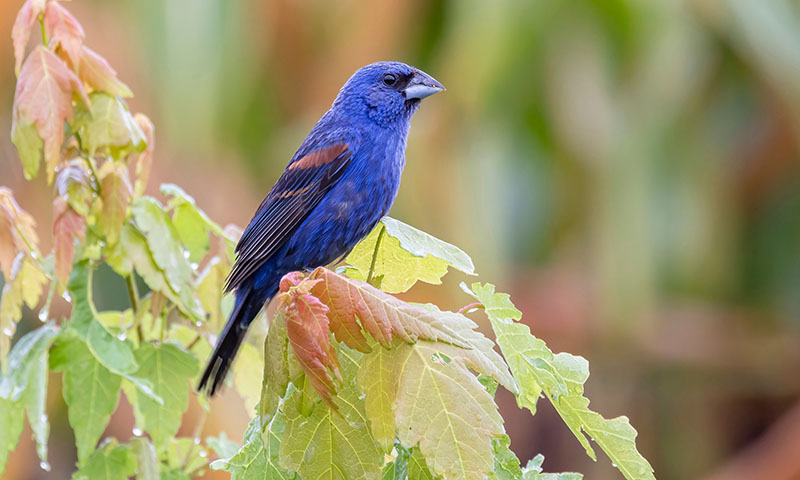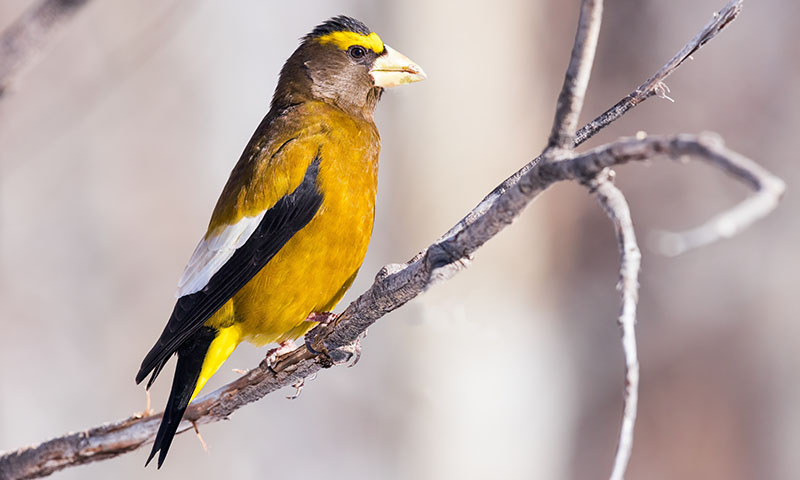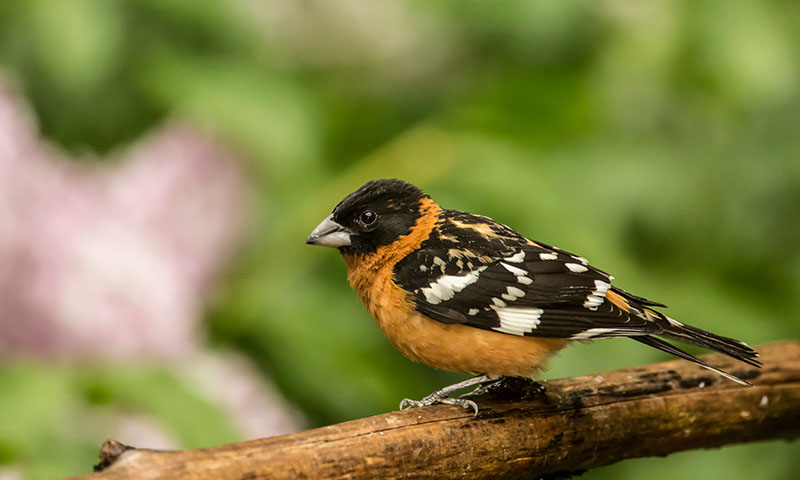All About Grosbeaks and How to Attract Them
Early on, naturalists and taxonomists classified and named birds based on physically similar attributes. Today, thanks to advancements in science, we also look to biological markers to determine relatedness.
Grosbeaks fall into an interesting category.
When they were first classified, several birds with a "thick beak" (gros means thick or large in French) were deemed a grosbeak. We now know that not all grosbeaks are genetically related.
Grosbeaks include a specific subset of finches, cardinals, weavers, tanagers, and more.
We spoke to Jordan Schaul, PhD, a former zoological curator who also worked in wildlife ecology and animal training, to learn more about grosbeaks. He holds degrees in biological psychology, zoology, and veterinary science.
"Grosbeak refers to a group of morphologically, but not necessarily biologically, related perching songbirds or passerines. It can be helpful to think of grosbeaks more specifically as cardinal grosbeaks, finch grosbeaks, and tanager grosbeaks," Schaul educated. "In addition, 10 subspecies of thick-billed weaver or grosbeak weavers are found across much of Sub-Saharan Africa. Looking at their beaks, you will see why they share the name."

Blue grosbeak perched on a maple branch.
How to Identify a Grosbeak
In addition to the thick, stout beaks used to crack open seeds, these songbirds also appear stocky and often with vibrant feathers.
5 popular grosbeaks
For example, the male Rose-breasted grosbeak from the cardinal family features black and white feathers set off by a red bib on the chest, whereas the male Blue grosbeak (also from the cardinal family) flaunts royal blue feathers accented with black and orange on the tail and wings.
The male Evening grosbeak, which belongs to the finch family, looks perfectly painted with its yellow headband on a brown and black head, white upper wings, black lower wings, and vibrant yellow body. Look closely! The Evening grosbeak has a slight greenish hue to its beak.
If you see a thick-beaked bird with an orange chest and a distinct black face mask with black and white two-tone wings, it's likely a male Black-headed grosbeak. They are closely related to the Rose-breasted grosbeaks.
The brilliant red head and bodice of the mostly gray and white male Pine grosbeak stands out against foliage. These birds hail from the finch family but lack the characteristic petite stature. In fact, Pine grosbeaks are the largest finch in the United States, Schaul shared. They measure 8 to 10 inches in length.
With all this talk about colorful male grosbeaks, you may wonder what the females look like. They feature muted colors when compared to their male counterparts.
Birdsong and behaviors
You can also identify a grosbeak by its melodious, whistled songs. Try using the Cornell University, Cornell Lab of Ornithology Merlin Bird ID app. Record the birdsong you hear, and the app will help you identify the species.
Or, maybe you get a chance to observe grosbeaks as they look for food or belt out a tune. Watch closely. Males can exhibit aggressive and territorial behaviors.
"For instance, the Blue grosbeak is known to mate guard. He will follow her as she forages. The Blue grosbeak's song attracts mates and warns other males to keep them from encroaching on their territories," Schaul explained. "Understanding these nuanced behaviors can help identify species."

Evening grosbeak perched on a branch.
Where to Find Grosbeaks in Nature
Since many varieties of grosbeaks exist, it's not surprising that some migrate and some stay put year-round.
"Some are short-distance migrants, and some are long-distance migrants. Northern cardinals, for example, do not migrate, while the Rose-breasted grosbeak is a long-distance migrant, breeding in North America and wintering in Central and South America," Schaul shared.
He says Black-headed grosbeaks are an example of a short-distance migratory bird. They tend to move between their breeding grounds in the western United States to their wintering range in central Mexico.
The grosbeaks in North America congregate in both evergreen and deciduous forests. The Evening grosbeak, specifically, prefers coniferous and mixed forests in the mountains on the West Coast of the United States.
"When I lived in south-central Alaska, the Pine grosbeak was not an uncommon visitor to feeders. Of course, they prefer coniferous forests," Schaul added.

Pine grosbeak in flight.
Bringing Grosbeaks to Your Backyard
Offering a bird bath that encourages drinking and bathing can attract grosbeaks to your property. This allows you a nice, clear view free of tree branches, too!
You can also attract grosbeaks to your feeder. Schaul says they prefer a gravity-fed hopper feeder or a platform/tray-style feeder. Both reduce seed spillage and attract a variety of birds — two bonuses for your bird-watching hobby!
Grosbeaks enjoy dining on black oil sunflower seeds. Their robust beaks make quick work of cracking open the seeds. Black oil sunflower seeds provide essential fat (and energy!) for wintering birds and those living in temperate regions.
"Mixed seed offerings are also enticing," he added. "Some wild bird feed products are tailored to cater to birds found in different geographic regions. Kaytee offers a great mixed seed product for western species (i.e., Kaytee Western Regional Blend Wild Bird Food)."
Consider one of these regional blends based on your location:
-
Kaytee Midwest Regional Wild Bird Blend: If you live in the Heartland and hope to spot cardinals, finches, chickadees, buntings, woodpeckers, and more, try this mix of sunflower hearts and chips, red millet, oil sunflower, niger seed, safflower, and white millet.
-
Kaytee Northeast Regional Wild Bird Blend: Do you call the northeastern United States home? Try this mix to attract cardinals, finches, jays, woodpeckers, chickadees, and more. They will enjoy the peanut hearts, sunflower hearts and chips, oil sunflower, white millet, niger seed, and red millet.
-
Kaytee Western Regional Blend: For those into birding on the West Coast of the United States, this blend brings finches, chickadees, jays, towhees, woodpeckers, and more to your feeder. The birds can explore sunflower hearts and chips, peanut hearts, canary seed, red and white millet, and niger seed.
-
Kaytee Southern Regional Wild Bird Blend: Birders living in the South may want to try this mix designed to attract cardinals, finches, woodpeckers, jays, chickadees, and more. It features sunflower hearts and chips, red millet, black oil sunflower seeds, peanut hearts, and more.

Black-headed grosbeak sitting on a branch.
Enjoy Birdwatching Grosbeaks
Beginning birders often find grosbeaks fascinating.
After all, they span several families of birds, including cardinals, finches, weavers, and tanagers, in a rainbow of colors and with an extended playlist of songs to observe.
Look for a thick beak, and you can likely add a grosbeak to your bird-watching list of accomplishments.
Elevate your bird-watching hobby by learning How to Attract Finches to Your Feeders and How to Attract: Cardinals.
